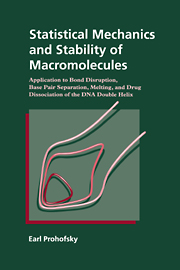 Statistical Mechanics and Stability of Macromolecules
Statistical Mechanics and Stability of Macromolecules Book contents
- Frontmatter
- Contents
- Preface
- 1 Introduction
- 2 Macromolecular stability
- 3 Lattice dynamics
- 4 Effective phonon theory
- 5 Premelting disrupted chemical bonds
- 6 Cooperative melting
- 7 Strained chemical bonds: salt and pressure effects
- 8 Bond disruption and conformation change: B to Z conformation change in DNA
- 9 Hydration effects: structural water
- 10 Helix with daunomycin intercalated: increased helix stability and daunomycin-DNA binding constant
- 11 Nonrepeating DNA
- 12 Cutting and splicing: junctions, inserts, and the replicating fork
- 13 Interaction between a helix and a single attached molecule
- 14 Energy considerations in bond opening
- Appendix 1 Helical lattice dynamics
- Appendix 2 Density matrix and effective phonon theory
- Appendix 3 Green functions
- References
- Index
12 - Cutting and splicing: junctions, inserts, and the replicating fork
Published online by Cambridge University Press: 16 September 2009
- Frontmatter
- Contents
- Preface
- 1 Introduction
- 2 Macromolecular stability
- 3 Lattice dynamics
- 4 Effective phonon theory
- 5 Premelting disrupted chemical bonds
- 6 Cooperative melting
- 7 Strained chemical bonds: salt and pressure effects
- 8 Bond disruption and conformation change: B to Z conformation change in DNA
- 9 Hydration effects: structural water
- 10 Helix with daunomycin intercalated: increased helix stability and daunomycin-DNA binding constant
- 11 Nonrepeating DNA
- 12 Cutting and splicing: junctions, inserts, and the replicating fork
- 13 Interaction between a helix and a single attached molecule
- 14 Energy considerations in bond opening
- Appendix 1 Helical lattice dynamics
- Appendix 2 Density matrix and effective phonon theory
- Appendix 3 Green functions
- References
- Index
Summary
Dealing with large macromolecules
Many problems of biological interest have to do with large macromolecules binding to other large macromolecules, giving rise to even larger systems. It would be an advantage if previous solutions of the dynamics of the separate macromolecules could be used in finding the dynamics of the combined macromolecules, rather than having to start each solution from scratch. This chapter discusses ways to use Green functions to determine the dynamics of a system that is made up of parts. Each of the parts can be analyzed separately and its spectrum compared to infrared and Raman observations allowing a refinement of the smaller problem. The dynamics of large macromolecules can then be constructed by combining dynamics of smaller molecules in much the same way as the actual molecules could be formed by chemically joining separate parts.
The scheme can also work for infinite systems whose separate parts have a symmetry that the combined system doesn't have. An example is the fork calculation introduced in the last chapter. The fork is the place where a section of double helical DNA is split into two single strands. Symmetry is broken by the fact that one half is double helical and the other half is single strands; the problem can't be reduced to block diagonalized finite secular matrices. Each separate part, extended in both directions, does have the proper symmetry.
- Type
- Chapter
- Information
- Statistical Mechanics and Stability of MacromoleculesApplication to Bond Disruption, Base Pair Separation, Melting, and Drug Dissociation of the DNA Double Helix, pp. 159 - 172Publisher: Cambridge University PressPrint publication year: 1995


